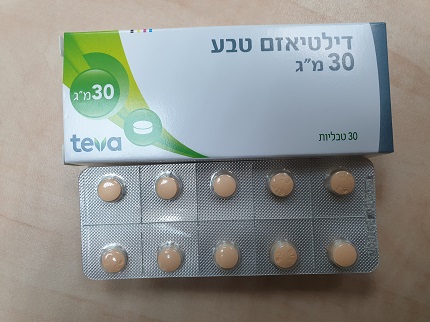Quest for the right Drug

דילטיאזם טבע 30 מ"ג DILTIAZEM TEVA 30 MG (DILTIAZEM HYDROCHLORIDE)
תרופה במרשם
תרופה בסל
נרקוטיקה
ציטוטוקסיקה
צורת מתן:
פומי : PER OS
צורת מינון:
טבליה : TABLETS
עלון לרופא
מינוניםPosology התוויות
Indications תופעות לוואי
Adverse reactions התוויות נגד
Contraindications אינטראקציות
Interactions מינון יתר
Overdose הריון/הנקה
Pregnancy & Lactation אוכלוסיות מיוחדות
Special populations תכונות פרמקולוגיות
Pharmacological properties מידע רוקחי
Pharmaceutical particulars אזהרת שימוש
Special Warning עלון לרופא
Physicians Leaflet
Posology : מינונים
Dosage and Administration Dosage should be individualized. Start with 30 mg 4 times daily, before meals and at bedtime. The dosage should be gradually increased to 240 mg (given in equal, divided doses 3-4 times daily) at 1-2-day intervals, until optimum response is obtained. There are no available data concerning dosage requirements in patients with impaired renal or hepatic function. If the drug must be used in such patients, titrate with particular caution. Concomitant Drug Therapy Sublingual nitroglycerin may be taken as required to abort acute anginal attacks during diltiazem therapy. Diltiazem may be safely co-administered with short- and long-acting nitrates, but there have been no controlled studies to evaluate the anti- anginal effectiveness of this combination. For use with β-blockers or digoxin, see Precautions. Use with caution in titrating dosages in patients suffering from impaired renal or hepatic function, since dosage requirements are not available. Mechanism of Action Diltiazem is a calcium antagonist (slow channel blocker) which inhibits the influx of calcium ions during membrane depolarization of cardiac and vascular smooth muscle. The resultant pharmacological effects on the cardiovascular system include depression of mechanical contraction of the myocardial and smooth muscle, and depression of both impulse formation (automaticity) and conduction velocity. Diltiazem dilates the coronary arteries and arterioles, both in normal and ischemic regions, and inhibits coronary artery spasm. This increases myocardial oxygen delivery in patients with vasospastic (Prinzmetal's or variant) angina. Although diltiazem rarely produces clinically important changes in the rate of sinoatrial (SA) node discharge or recovery time, the drug usually reduces the resting heart rate slightly, especially in patients with SA node disease (e.g. sick sinus syndrome). Diltiazem also slows atrioventricular (AV) node conduction and prolongs refractoriness, thereby prolonging the AH (Atria-His bundle) interval. This usually results in PR prolongation on ECG and may rarely cause second- or third-degree AV block. Following oral administration, diltiazem is about 80-90% absorbed with a single absolute bioavailability of 40-67%. Onset of action occurs 30 minutes after an oral dose, with peak plasma levels occurring after 2-3 hours. Plasma protein binding is 70-80%. Plasma elimination half-life is 3.5-9 hours. Therapeutic serum levels are in the range of 0.04-0.2 mcg/ml. Diltiazem is subject to extensive first pass hepatic metabolism, the main metabolite being deacetyl-diltiazem. This metabolite is present in the plasma at levels of 10- 20% of the parent drug and is 25-50% as potent a coronary vasodilator as diltiazem. About 2-4% of the drug is excreted unchanged in the urine.

מסגרת הכללה בסל
התוויות הכלולות במסגרת הסל
| התוויה | תאריך הכללה | תחום קליני | Class Effect | מצב מחלה |
|---|---|---|---|---|
| לב וכלי דם | AMLODIPINE, FELODIPINE, DILTIAZEM, LERCANIDIPINE |
שימוש לפי פנקס קופ''ח כללית 1994
Vasospastic angina (Prinzmetal), chronic stable angina
תאריך הכללה מקורי בסל
01/01/1995
הגבלות
תרופה שאושרה לשימוש כללי בקופ'ח
מידע נוסף
